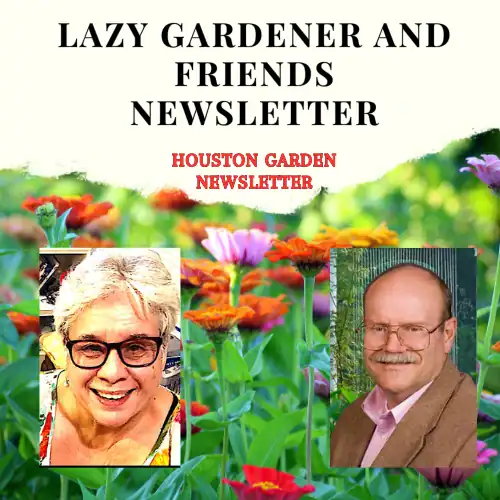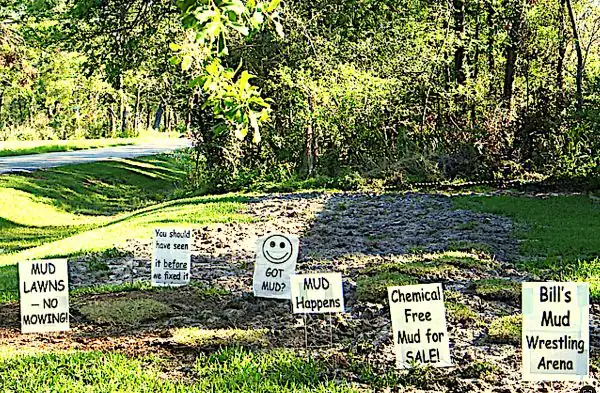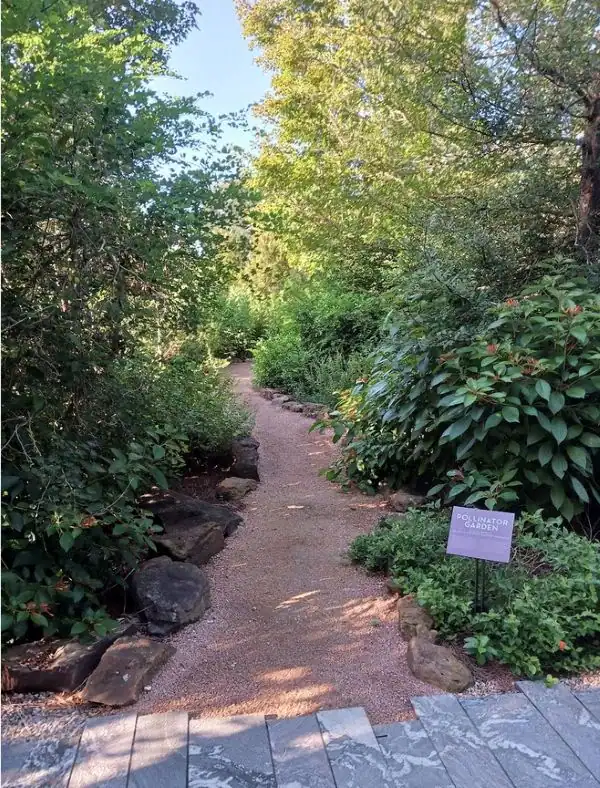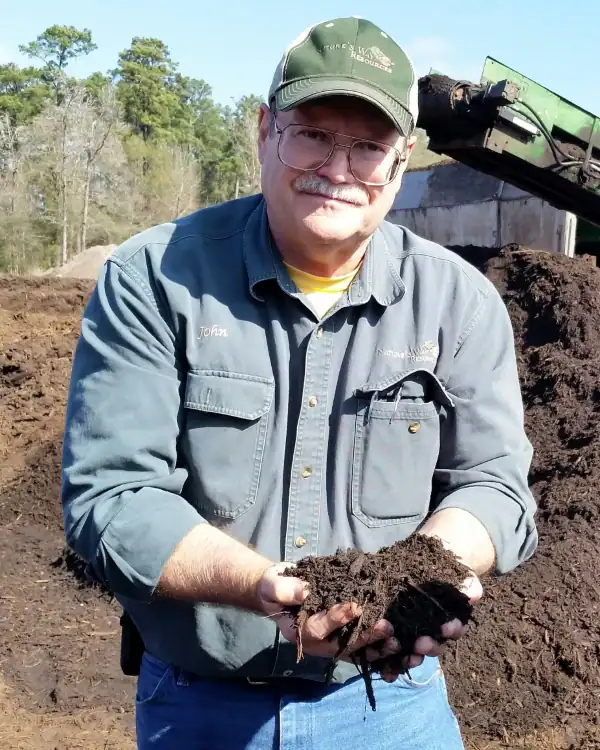
Nature’s Way Resources is proud to produce & email you this free weekly newsletter. We have no ads, but sponsors do graciously help support this project as a public service. Please note their names below & show your gratitude for this free service by patronizing their businesses! To become a sponsor, call (936) 273-1200
Nature’s Way Resources owner John Ferguson, “The Lazy Gardener” Brenda Beust Smith, and Shelby Cassano welcome your feedback and are so grateful to the many horticulturists who contribute their expertise
“In laying out a garden, the first and chief thing to be considered is the “genius of the place.” — Alexander Pope (1688-1744) English poet and satirist.

WIPE THOSE SMILES OFF, PROFESSIONAL
LANDSCAPERS — WE CAN FIND ‘GENIES’ TOO!
by Brenda Beust Smith | The Lazy Gardener
Understand the quote at top? I didn’t until I researched it after reading Stephanie Barron’s “Jane and the Genius of the Place.” (“Jane”, as in Jane Austin)
The “genius loci ” was the protective spirit of a place “. . . harmonious connections to history, geography, local culture. . .?” and much, much more. What fun!
Professional landscapers are probably smiling at my naivety, but we lazy gardeners don’t sweat that sort of thing. We plant and hope all are happy enough to root ‘n’ grow! Yet this concept is a delight and made my gardening more fun.
To find the “Genies of YOUR place,” consider these key points:
- What are unique characteristics and spirit of YOUR landscape (think of whole place, not just one garden spot)? What do people notice/comment on when viewing your property for the first time?
- What about your garden is MOST important to you? Make you smile? Remind you of favorite places, people, or events? Attracts wanted wildlife into your life? Makes you proud?
- Does your yard “fit in” with surrounding natural environment? Do you want it to? Or rather it ‘stands out.’
- Is it Nature-friendly? Are you ok with whatever you answer?
No right or wrong answers. It’s what’s in YOUR head, YOUR heart (and won’t bring HOA knocking on your door, of course).
Tried this on my yard, and all I could come up with is “this” ____ makes me smile . . . or . . . wish “that” ____ would go away.” Can’t have things 100% all the time! But hope your “Genius of the Place” musings help make easier difficult decisions on what to put where! Who else would tell you these things?
* * *
HAPPY 5th BIRTHDAY,
HOUSTON BOTANIC GARDEN!

So many people worked for so long to make this 132-acre treasure a reality. (I vividly remember co-founder Nancy Thomas almost in (happy!) tears with best friend Sally McQueen Squire (my editor/publisher) when they realized this garden really was becoming a reality after decades of dreaming and planting. Now, much bigger plans are in the works. Don’t miss this opportunity to see, learn, and celebrate the birthday of this now incredible Greater Houston Area treasure!
* * *

SPOTLIGHTING: NEW STARS . . . THE ANNUAL GARDEN CLUB OF HOUSTON’s BULB MART often offers cacti and other outstanding succulents. But this time the spotlight is brighter. To name just a few (left to right), Co-Succulent Booth Chairs Michelle Williams and Stephanie Shanks are especially delighted with . . .
- Zebra Plant (Hawarthiopsis fasciata) left above) Good-looking succulent, best grown in a container to protect from rain. Likes full sun and temps 40° to 100°. Water after soil dries out, every 1-2 weeks depending on temperatures. Propagate by dividing plants at the root.
- Ghost Plant (Graptopetalum paraguayense) Sometimes described “difficult to grow, its gray color looks great mixed with other succulents, The Ghost Plant is well-suited to Houston’s weather. Mostly planted in containers protected from rain, though occasional light rain is fine. It prefers 5-6 hours of full sun and infrequent watering (every 2 weeks in mild weather, 1 time per week in hot summer). Pinched off a stem with some leaves and put in dirt. It will root and grow. Protect from temperatures below 20°.
- String of Pearls (Curio rowleyanus) Fairly easy to grow in a container, String of Pearls makes a great show trailing over edges of pots. It likes full sun. Water when soil dries out, more frequently in hot weather. It prefers temps 40°-100°, but will tolerate a little cold. Protect from winter cold temps.
* * *

ATTN. GARDEN/PLANT GROUPS
— Nature’s Way Resources offers free guided tours of NWR’s extensive nursery/soil/mulch facilities for garden clubs, plant societies and other plant-oriented, organized groups. As usual, NWR’s now-expanded meeting site is free to above groups. Reservations a must for both. Great time to visit.

Submitting a Calendar Event?
For best chance of getting it in next upcoming newsletter, submit in exact requested format (see top of calendar below. Reformatting by us may = delay in publication)
John’s Corner
NEWS FROM THE WONDERFUL WORLD OF SOIL AND PLANTS
#346
Subject: Hardwood Bark Mulches
Many mulches can be useful or bad depending on how they are used. Also, many different types of mulches are called by the same “common name”. In our area, hardwood mulch is produced predominantly from our many species of oak trees.
Historically, 50 years ago, we had millions of cubic yards of bark aging for many years and naturally turning it very dark. This long aging process allowed many of the toxic chemicals in the bark to biodegrade. All the old, aged bark was used up many years ago, hence hardwood bark today is very different that 20 years ago.
Bark mulches are made from the protective outer layer of trees and are produced as a by-product of the lumber and pulp industries. Since outer bark is designed as a protective layer for the tree, it tends to be low in nutrients. Tree barks frequently contain the chemical suberin, a naturally occurring substance that waterproofs (helps bark shed water) and prevents the bark from being broken down by soil microorganisms. In addition to suberin, barks contain waxes that also help waterproof the tree. Hence, the suberin in the bark can slow or retard the growth of some plant species. Additionally, barks contain very little energy-releasing compounds used by the soil microorganisms that are extremely important to soil and plant health.
All organic materials that were once alive have a C:N ratio (Carbon to Nitrogen). For example, bark mulches (both pine and hardwood) have a C:N ratio of near 500:1. Healthy, fertile soil is 30:1.
The first problem a gardener or landscaper encounters is nature will break down these mulches over time, but it requires a lot of nitrogen (along with my other nutrients or elements). To do this, the microbes use nitrogen in the soil, taking it away from the plants. As a result, the plants become stressed, resulting in increased disease and insect pressure.
To reduce this problem, many gardeners require a lot of toxic, expensive synthetic fertilizer, resulting in hidden costs, which then creates other problems from compaction and hardpan, to increased disease and insect damage.
Another problem a gardener or landscaper encounters when they use hardwood bark is an increase in both plant and soil diseases. Barks have chemicals in them to kill microbes and prevent decay. These chemicals, along with those mentioned above, include turpentine, phenolics, tannins, etc., that kill the good microbes needed for plants to be healthy and absorb nutrients from the soil. Without good microbes, the pathogens have no natural control, and often expensive and toxic fungicides are required. Pest insects such as fire ants love this type of environment as they have no natural predators. Again, another hidden cost.
Often, hardwood barks tend to float away in the rain and make a messy situation that customers do not like. Hardwood bark mulches tend to become hydrophobic and repel water, keeping it from entering the soil.
They also often seal the soil with ugly fungus mats and slimes, preventing air (oxygen) from entering the soil. Again, we get increased disease, drought stress (wilting), poor growth, and increased insect damage. (another hidden cost).
The picture below is a photo of Dog Puke Fungus. AS it grows it seals the soil preventing air and water from entering.

Often, the barks are not given time to darken naturally; hence, to darken or color the mulches, toxic chemicals and dyes may be used, which have been discussed in the previous article.
Large pieces of bark are slower to break down and less likely to blow and wash away than finely ground pieces, but they are considered more difficult to work around. Any bark that is high in tannic acids and phenols is potentially harmful unless thoroughly composted and leached.
Fine-ground pine bark packs down and prevents oxygen from reaching the soil. It is difficult to get wet; it sheds rain after it dries out and prevents moisture from reaching the plant’s roots. Often, when trees are dying from disease, they are cut for pulp or lumber, and the diseased bark ends up being sold to consumers.
Many tree biologists, anatomists, arborists, soil ecologists, and other experts now recommend that bark-based mulches be avoided. Dr. Alex Shigo at the University of Georgia, a leading tree expert, has several papers posted on the Internet about this subject.
The natural chemicals in pine bark tend to kill off many species of beneficial microbes that naturally attack and prey on fire ants and termites; hence, problems with these insects are reported to be more common when bark is used.
Click below to learn more about all of the different types of mulch in detail.
Explore our article library to learn more information about various mulches and other topics.
Sponsorship
If you are interested in becoming a sponsor, please contact us at 936-273-1200 or send an e-mail to: lazygardenerandfriends@gmail.com
About Us
BRENDA BEUST SMITH
WE KNOW HER BEST AS THE LAZY GARDENER . . .
but Brenda Beust Smith is also:
- a national award-winning writer & editor
- a nationally-published writer & photographer
- a national horticultural speaker
- a former Houston Chronicle reporter
When the Chronicle discontinued Brenda’s 45-year-old Lazy Gardener” print column — started in the early ’70s as a fun side-project to reporting, it then ranked as the longestrunning, continuously-published local newspaper column in the Greater Houston area. The name, she says, is not just fun, it’s true.
Brenda’s gradual sideways step from reporter into gardening writing led first to an 18-year series of when-to-do-what Lazy Gardener Calendars, then to her Lazy Gardener’s Guide book which morphed into her Lazy Gardener’s Guide on CD, which she now emails free upon request.
Brenda became a Harris County Master Gardener and, over the years, served on theboards of many Greater Houston area horticulture organizations. She hosted local radio and TV shows, most notably a 10+-year Lazy Gardener specialty shows on HoustonPBS (Ch. 8) and her call-in “EcoGardening” show on KPFT-FM.
For over three decades, Brenda served as Assistant Production Manager of the GARDEN CLUB OF AMERICA’S “BULLETIN” magazine. Although still an active broad-based freelance writer, Brenda’s main focus now is THE LAZY GARDENER & FRIENDS HOUSTON GARDEN NEWSLETTER with John Ferguson and Pablo Hernandez of Nature’s Way Resources.
A native of New Orleans and graduate of St. Agnes Academy and the University of Houston, Brenda lives in Humble, TX, and is married to the retired Aldine High School Coach Bill Smith. They have one son, Blake.
Regarding this newsletter, Brenda is the lead writer, originator of it and the daily inspiration for it. We so appreciate the way she has made gardening such a fun way to celebrate life together for such a long time.
About her column, Brenda says: “I don’t consider myself a ‘garden writer.” I started out 50+ years ago as a very lazy “gardening reporter.” I still feel that way today. I hope my columns inspire/help newcomers, but I do not write to them. I write to very experienced gardeners who want to expand their horizons.
JOHN FERGUSON
John is a native Houstonian and has over 35 years of business experience. He owns Nature’s Way Resources, a composting company that specializes in high quality compost, mulch, and soil mixes. He holds a MS degree in Physics and Geology and is a licensed Soil Scientist in Texas.
John has won many awards in horticulture and environmental issues. For years he represented the composting industry on the Houston-Galveston Area Council for solid waste. His personal garden has been featured in several horticultural books and “Better Homes and Gardens” magazine. His business has been recognized in the Wall Street Journal for the quality and value of their products. He is a member of the Physics Honor Society and many other professional societies. John is the co-author of the book Organic Management for the Professional.
For this newsletter, John contributes articles regularly and is responsible for publishing it.
PABLO HERNANDEZ Pablo Hernandez is the special projects coordinator for Nature’s Way Resources. His realm of responsibilities include: serving as a webmaster, IT support, technical problem solving/troubleshooting, metrics management and quality control. Pablo helps this newsletter happen from a technical support standpoint.
Download the Newsletter with Our Events Calendar Below!

NATURE’S WAY RESOURCES
101 Sherbrook Cir.
Conroe, TX 77385
Hours of Operation
Monday – Friday: 8AM to 5PM
Saturday: 8AM to 2PM
Copyright © 2024 Nature’s Way Resources | All rights reserved.



